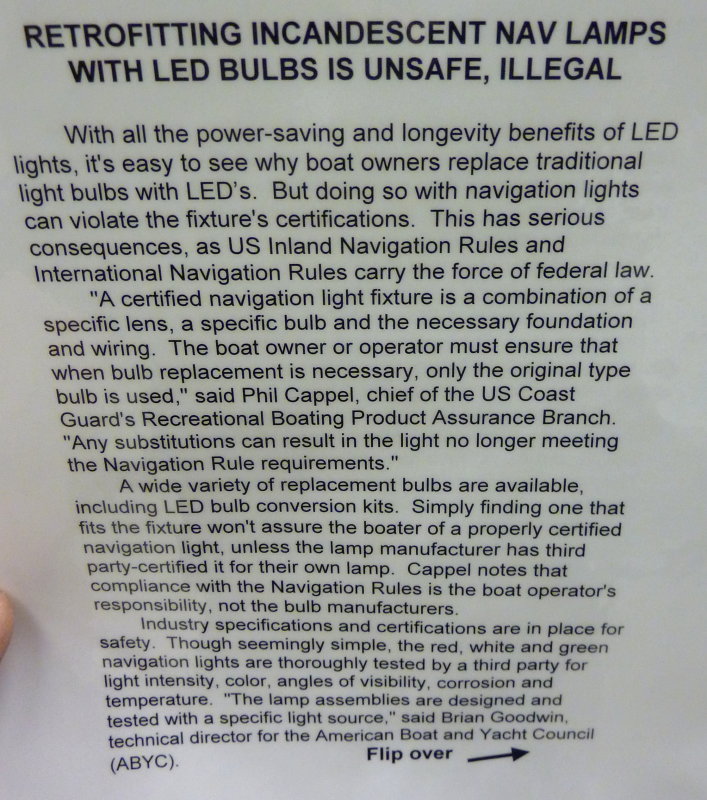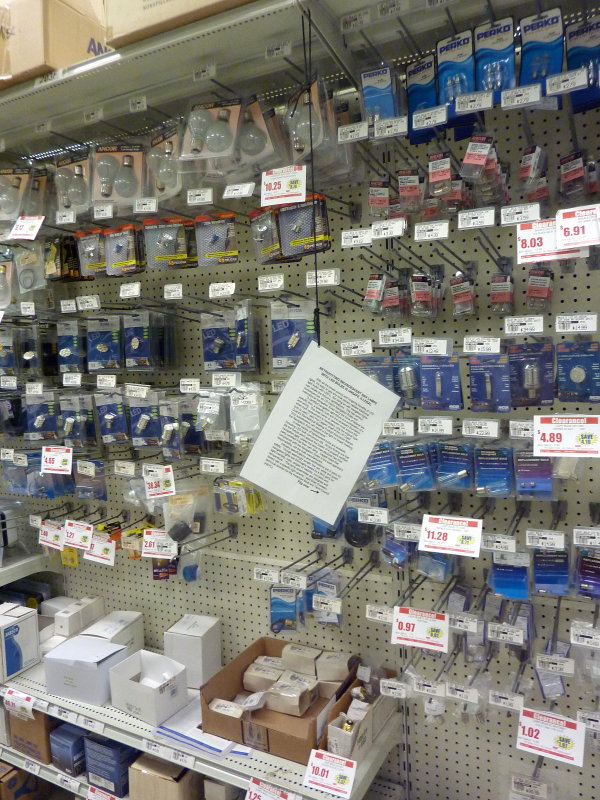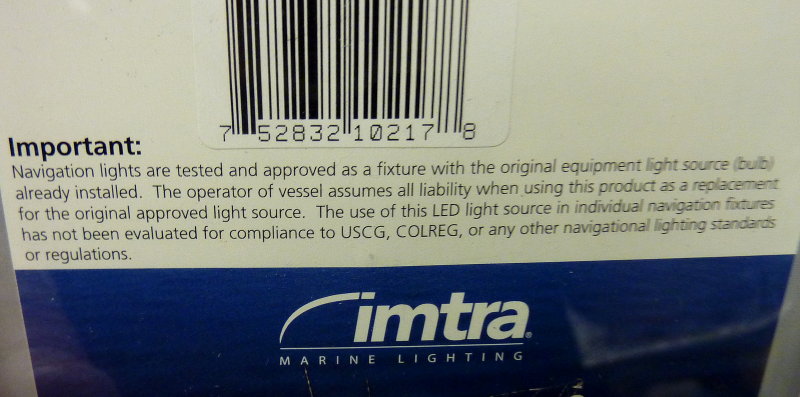For our Bow and Stern Lights - are they pointed or dimpled? My manuals are missing, anyone know make / model of fixture?
Thanks - Christmas shopping here....
Keep in mind that your nav lights need to meet the COLREGS definitions of a navigation light. This is federal law.
How will you know that a home made navigational light will meet the horizontal sectors, vertical sectors, color and distance specifications? If you are willing to take on that risk, that is fine, I just point it out because folks only tend to think the COLREGS is only about distance and that is simply not true.
There is a part in Rule 20 of the COLREGS that states nav lights SHALL COMPLY with Annex I of the CFR / Code of Federal Regulations, and many folks miss this critical section.
This is what it means, by US Federal Law and the COLREGS to be considered a "navigation light"....
From 33 CFR 84:
Colors
� 84.13 Color specification of lights
(a) The chromaticity of all navigation lights shall conform to the following standards, which lie within the boundaries of the area of the diagram specified for each color by the International Commission on Illumination (CIE), in the "Colors of Light Signals", which is incorporated by reference. It is Publication CIE No. 2.2. (TC-1.6), 1975, and is available from the Illumination Engineering Society, 345 East 47th Street, New York, NY 10017. It is also available for inspection at the Office of the Federal Register, Room 8401, 1100 L Street N.W., Washington, D.C. 20408. This incorporation by reference was approved by the Director of the Federal Register.
(b) The boundaries of the area for each color are given by indicating the corner coordinates, which are as follows:
(1) White:
x 0.525 0.525 0.452 0.310 0.310 0.443
y 0.382 0.440 0.440 0.348 0.283 0.382
(2) Green:
x 0.028 0.009 0.300 0.203
y 0.385 0.723 0.511 0.356
(3) Red:
x 0.680 0.660 0.735 0.721
y 0.320 0.320 0.265 0.259
(4) Yellow:
x 0.612 0.618 0.575 0.575
y 0.382 0.382 0.425 0.406
Intensity
� 84.15 Intensity of lights
(a) The minimum luminous intensity of lights shall be calculated by using the formula:
l = 3.43 x 106 x T x D2 x K-D
where:
I is luminous intensity in candelas under service conditions, T is threshold factor 2 x 10-7 lux, D is range of visibility (luminous range) of the light in nautical miles, K is atmospheric transmissivity. For prescribed lights the value of K shall be 0.8, corresponding to a meteorological visibility of approximately 13 nautical miles.
(b) A selection of figures derived from the formula is given in Table 84.15(b).
Table 84.15(b)
Range of visibility (luminous Minimum
range) of light in nautical luminous intensity of light
miles in candelas tor K = 0.8
D I
1 0.9
2 4.3
3 12
4 27
5 52
6 94
Horizontal Sectors
� 84.17 Horizontal sectors
(a)
(1) In the forward direction, sidelights as fitted on the vessel shall show the minimum required intensities. The intensities shall decrease to reach practical cut-off between 1 and 3 degrees outside the prescribed sectors.
(2) For sternlights and masthead lights and at 22.5 degrees abaft the beam for sidelights, the minimum required intensities shall be maintained over the arc of the horizon up to 5 degrees within the limits of the sectors prescribed in Rule 21. From 5 degrees within the prescribed sectors the intensity may decrease by 50 percent up to the prescribed limits; it shall decrease steadily to reach practical cutoff at not more than 5 degrees outside the prescribed sectors. (b) All-round lights shall be so located as not to be obscured by masts, topmasts or structures within angular sectors of more than 6 degrees, except anchor lights prescribed in Rule 30, which need not be placed at an impracticable height above the hull, and the all-round white light described in Rule 23(d), which may not be obscured at all. (c) If it is impracticable to comply with paragraph (b) of this section by exhibiting only one all-round light, two all-round lights shall be used suitably positioned or screened to appear, as far as practicable, as one light at a minimum distance of one nautical mile.
NOTE to paragraph (c): Two unscreened all-round lights that are 1.28 meters apart or less will appear as one light to the naked eye at a distance of one nautical mile.
Vertical Sectors
� 84.19 Vertical sectors
(a) The vertical sectors of electric lights as fitted, with the exception of lights on sailing vessels underway and on unmanned barges, shall ensure that:
(1) At least the required minimum intensity is maintained at all angles from 5 degrees above to 5 degrees below the horizontal;
(2) At least 60 percent of the required minimum intensity is maintained from 7.5 degrees above to 7.5 degrees below the horizontal.
(b) In the case of sailing vessels underway the vertical sectors of electric lights as fitted shall ensure that:
(1) At least the required minimum intensity is maintained at all angles from 5 degrees above to 5 degrees below the horizontal;
(2) At least 50 percent of the required minimum intensity is maintained from 25 degrees above to 25 degrees below the horizontal.
(c) In the case of unmanned barges the minimum required intensity of electric lights as fitted shall be maintained on the horizontal.
(d) In the case of lights other than electric lights these specifications shall be met as closely as possible.
This is what USCG / ABYC A-16 navigation lights are tested to and all nav lights "shall comply" with regardless of certification..
To see where in the COLREGS lights are defined and what those requirements are you need to look no further than Rule 20:
USCG Nav Center said:
USCG Nav Center said:
(a) Rules in this part shall be complied with in all weathers.
(b) The Rules concerning lights shall be complied with from sunset to sunrise, and during such times no other lights shall be exhibited, except such lights which cannot be mistaken for the lights specified in these Rules or do not impair their visibility or distinctive character, or interfere with the keeping of a proper look-out.
(c) The lights prescribed by these Rules shall, if carried, also be exhibited from sunrise to sunset in restricted visibility and may be exhibited in all other circumstances when it is deemed necessary.
(d) The Rules concerning shapes shall be complied with by day.
(e) The lights and shapes specified in these Rules shall comply with the provisions of Annex I [to these Regulations | of these Rules].
Annex I takes you straight to the CFR definitions of a nav light as posted above... "
shall comply with the provisions of Annex I" is not worded lightly. This means every boaters nav lights shall comply with the CFR specs above.. "Shall comply" is not a gray area...
There are plenty of certified NAV lights on the market that meet the COLREGS standards but only two or three tested and certified for use in an already existing fixture. The only after market bulb that is certified, and has the testing certs to back it up, for use in existing fixtures, are made by Dr. LED but only for use in certain Aqua Signal Series 40 fixtures. They have certifications for bow red, bow green and all-round.. However the red/green FAILED to meet the specs & pass certifications for a sailboat so the only certified aftermarket bulb is the PolarStar 40 anchor light when used in an Aquasignal Series 40 All Round. Even Dr. LED can't pass certifications for a sail boat how can you as a DIY be sure..????
Remember there is no requirement I know of that says you as a private boat owner must install "certified" lights. However, it is the
law that your lights "
shall comply" with Rule 20 / 33CFR 84 for distance, horizontal sectors, color and vertical sectors. How do you know they will, without any testing?
The easiest way to know your lights comply is to simply purchase USCG / ABYC A-16 certified navigation lights. Prices have come way down in recent months...
 I am very bad at being able to search / retrieve data from the posts.
I am very bad at being able to search / retrieve data from the posts.




